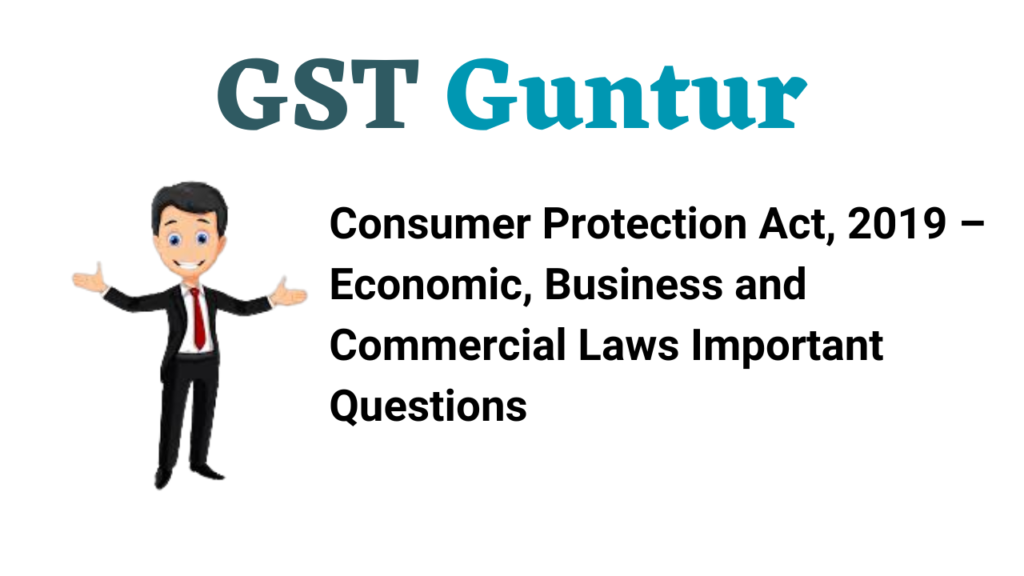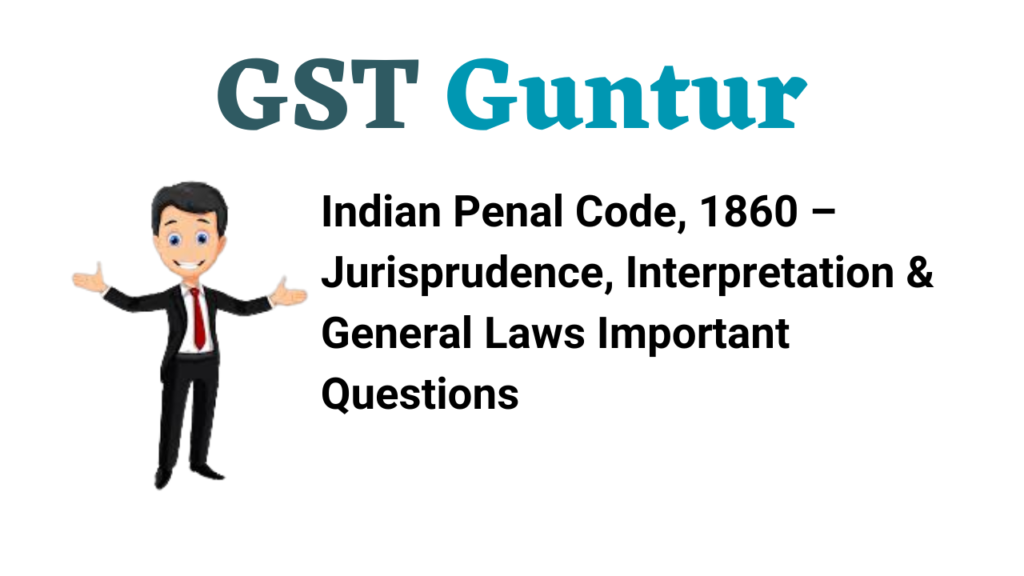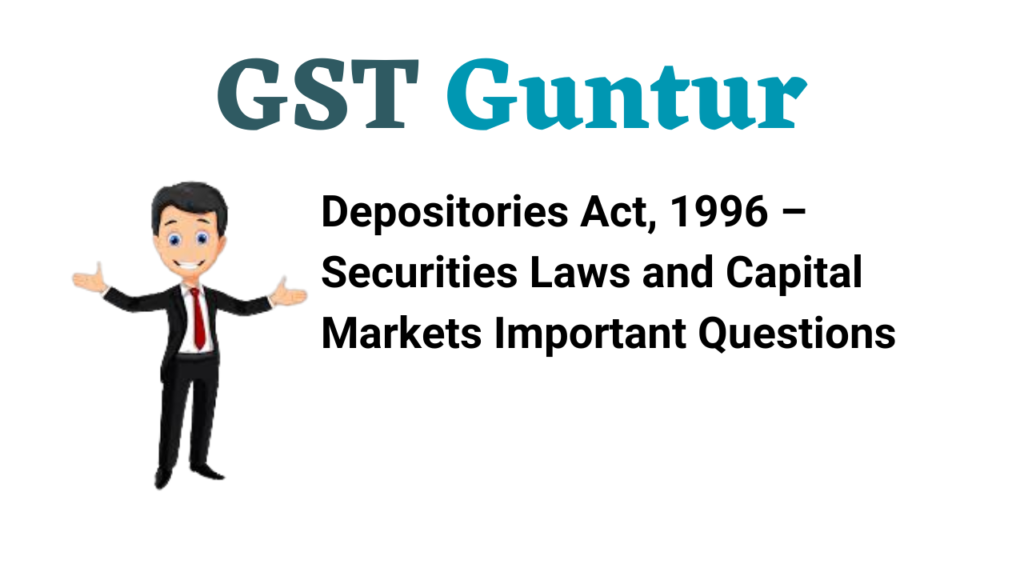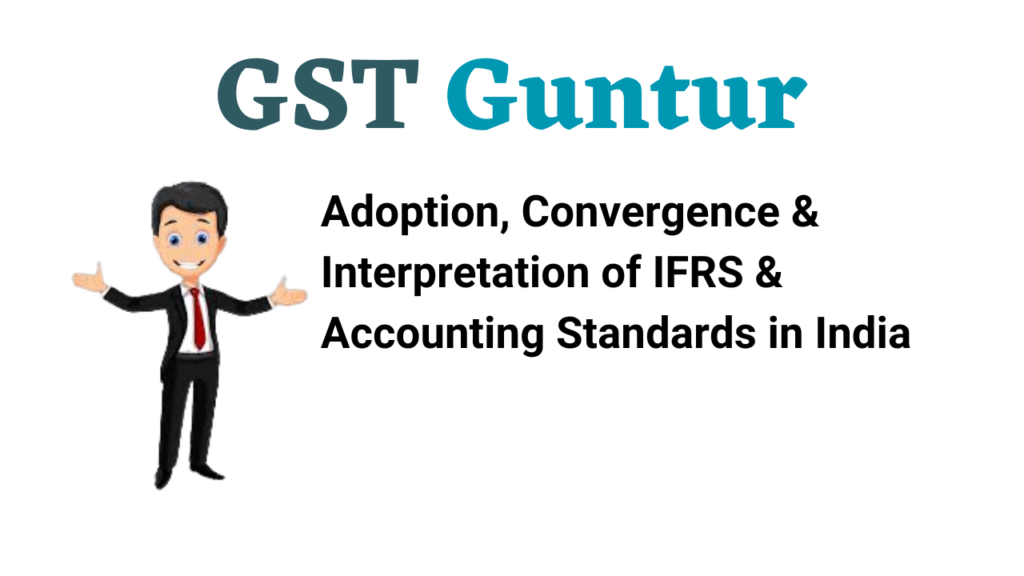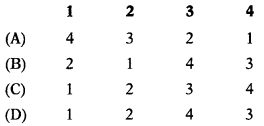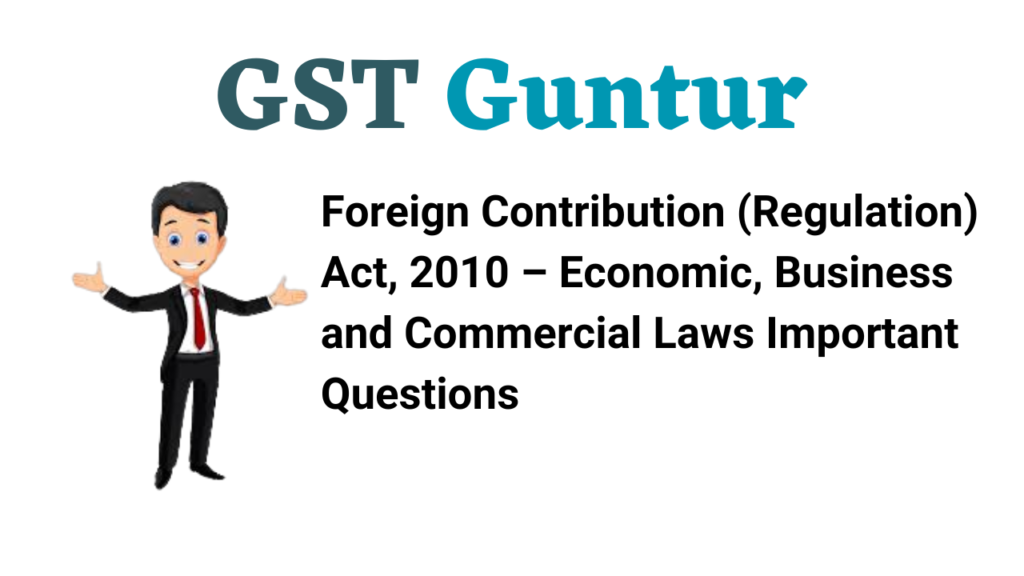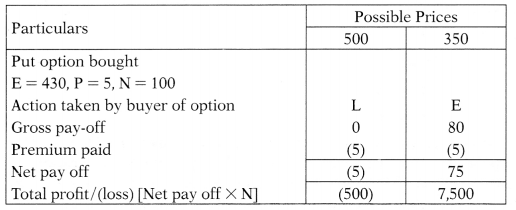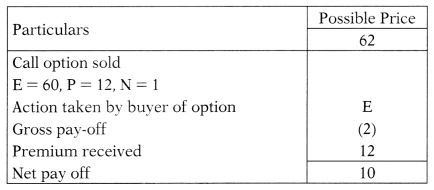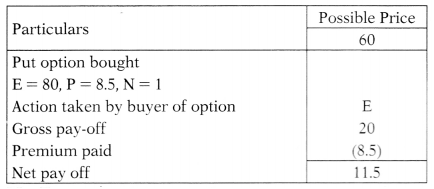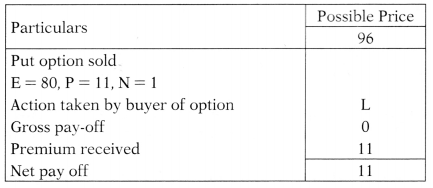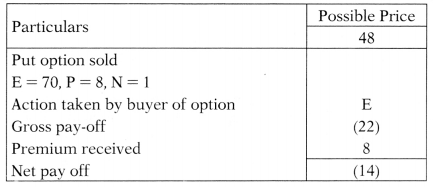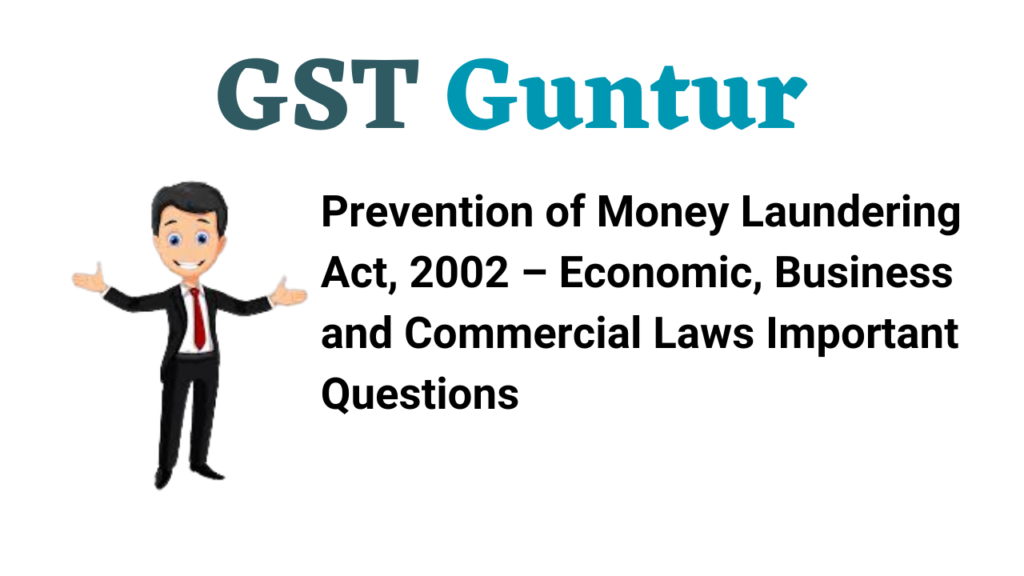Consumer Protection Act, 2019 – Economic, Business and Commercial Laws Important Questions
Consumer Protection Act, 2019 – Economic, Business and Commercial Laws Important Questions
Question 1.
Write a short note on the Basic rights of consumers [June 2013 (3 Marks)]
Answer:
Consumer rights are defined u/s 2(9) of Consumer Protection Act, 2019 as:
Consumer rights include:
- the right to be protected against the marketing of goods, products, or services which are hazardous to life and property;
- the right to be informed about the quality, quantity, potency, purity, standard, and price of goods, products or services, as the case may be, so as to protect the consumer against unfair trade practices;
- the right to be assured, wherever possible, access to a variety of goods, products, or services at competitive prices;
- the right to be heard and to be assured that consumer’s interests will receive due consideration at the appropriate forum;
- the right to seek redressal against unfair trade practice or restrictive trade practices or unscrupulous exploitation of consumers; and
- the right to consumer awareness.
Question 2.
Discuss the basic rights of consumers under the Consumer Protection Act, 2019. [June 2014 (8 Marks)]
Answer:
Consumer rights are defined u/s 2(9) of Consumer Protection Act, 2019 as:
Consumer rights include:
- the right to be protected against the marketing of goods, products, or services which are hazardous to life and property;
- the right to be informed about the quality, quantity, potency, purity, standard, and price of goods, products or services, as the case may be, so as to protect the consumer against unfair trade practices;
- the right to be assured, wherever possible, access to a variety of goods, products, or services at competitive prices;
- the right to be heard and to be assured that consumer’s interests will receive due consideration at the appropriate forum;
- the right to seek redressal against unfair trade practice or restrictive trade practices or unscrupulous exploitation of consumers; and
- the right to consumer awareness.
Question 3.
What are the basic rights of consumers that arc sought to be promoted j and protected under the Consumer Protection Act, 2019? [June 2015 (5 Marks)]
Answer:
Consumer rights are defined u/s 2(9) of Consumer Protection Act, 2019 as:
Consumer rights include:
- the right to be protected against the marketing of goods, products, or services that are hazardous to life and property;
- the right to be informed about the quality, quantity, potency, purity, standard, and price of goods, products or services, as the case may be, so as to protect the consumer against unfair trade practices;
- the right to be assured, wherever possible, access to a variety of goods, products, or services at competitive prices;
- the right to be heard and to be assured that consumer’s interests will receive due consideration at the appropriate forum;
- the right to seek redressal against unfair trade practice or restrictive trade practices or unscrupulous exploitation of consumers; and
- the right to consumer awareness.
Question 4.
Write a short note on Commercial Purpose [Dec. 2009 (3 Marks)]
Answer:
(a) Not a consumer: As per the definition of ‘Consumer’ as defined under the Consumer Protection Act, 2019, if a person purchases the goods for ‘commercial purpose’ then he is not ‘Consumer’ and no benefit under the Act will be available to him.
(b) Criteria for Commercial Purpose: Goods purchased are for commercial purpose in the following conditions are satisfied
- Used for profit-making activity on large scale and
- There is a close and direct nexus between the purchase of goods and profit-making activity
(c) Commercial purpose does not include use by a consumer of goods bought and used by him and services availed by him exclusively for the purpose of earning his livelihood, by means of self-employment.
(d) Laxmi Engineering Works v. P.S.G. Industrial Institute: Supreme Court in Laxmi Engineering Works v. P.S. G. Industrial Institute held that the purpose for which a person has bought goods is a ‘commercial purpose’ is always a question of facts and to be decided in the facts and circumstances of each case.
If the commercial use is by the purchaser himself for the purpose of earning his livelihood by means of self-employment such purchaser of goods would yet be a consumer. The Supreme Court further observed that if a person purchased a machine to operate it himself for earning his livelihood, he would be a consumer. If such a person took the assistance of one or two persons to assist him in operating the machine, he would still be a consumer.
But if a person purchases a machine and appoints or engages another person exclusively to operate the machine, then such person would not be a consumer.
Question 5.
Jolly Ltd. maintained a guest house or the use of its managing director and other executives. It entered into an agreement with a firm for the installation of the central air-conditioning system. The system installed did not function, developed snags and there was leakage of water from the ducting system. The company filed a complaint claiming compensation for deficiency in service under the Consumer Protection Act, 2019. Will it succeed? Give reasons with reference to case law, if any. [June 2010 (5 Marks)]
Answer:
(a) Facts of Case: Jolly Ltd. maintained a guest house for the use of its managing director and other executives. It entered into an agreement with a firm for the installation of the central air-conditioning system. The system installed did not function, developed snags and there was leakage of water from the ducting system. The company filed a complaint claiming compensation for deficiency in service under the Consumer Protection Act, 2019.
(b) Provision: In J.K. Puri Engineers v. Mohan Breweries & Distilleries Ltd., it was held that even where the goods are purchased for commercial purpose, if there is a warranty, as in this case, for its maintenance, the purchaser becomes a consumer in respect of the services rendered or to be rendered by the manufacturer or supplier during the warranty period.
The complainant is, therefore, a consumer. The system was installed only to provide comfort to directors and other executives who have not been used for commercial purposes. Further the complainant had drawn the attention of the service provider and there was no reply from them for quite some time, there was thus a gross deficiency in service.
(c) Conclusion: Thus, Jolly Ltd. can file a complaint before the consumer forum and it will succeed.
Question 6.
Write a short note on Commercial Purpose [Dec. 2012 (3 Marks)]
Answer:
(a) Not a consumer: As per the definition of ‘Consumer’ as defined under the Consumer Protection Act, 2019, if a person purchases the goods for ‘commercial purpose’ then he is not ‘Consumer’ and no benefit under the Act will be available to him.
(b) Criteria for Commercial Purpose: Goods purchased are for commercial purpose in the following conditions are satisfied
- Used for profit-making activity on large scale and
- There is a close and direct nexus between the purchase of goods and profit-making activity
(c) Commercial purpose does not include use by a consumer of goods bought and used by him and services availed by him exclusively for the purpose of earning his livelihood, by means of self-employment.
(d) Laxmi Engineering Works v. P.S.G. Industrial Institute: Supreme Court in Laxmi Engineering Works v. P.S. G. Industrial Institute held that the purpose for which a person has bought goods is a ‘commercial purpose’ is always a question of facts and to be decided in the facts and circumstances of each case.
If the commercial use is by the purchaser himself for the purpose of earning his livelihood by means of self-employment such purchaser of goods would yet be a consumer. The Supreme Court further observed that if a person purchased a machine to operate it himself for earning his livelihood, he would be a consumer. If such a person took the assistance of one or two persons to assist him in operating the machine, he would still be a consumer.
But if a person purchases a machine and appoints or engages another person exclusively to operate the machine, then such person would not be a consumer.
Question 7.
Ramesh, an industrial employee contributing to ESI Fund was treated in an ESI hospital. Due to a negligent diagnosis at the hospital, his condition deteriorated and he had to be shifted to a private hospital. He filed a complaint before the Consumer Disputes Redressal Forum seeking compensation from the ESI hospital. His complaint was dismissed on the ground that medical service rendered by the ESI hospital was gratuitous in nature. The State Commission and the National Commission upheld the decision of the District Forum. Ramesh intends to prefer an appeal before the Supreme Court. Will he succeed? Give reasons. [June 2013 (5 Marks)]
Answer:
(a) Facts of Case: Ramesh, an industrial employee contributing to ESI Fund was treated in an ESI hospital. Due to a negligent diagnosis at the hospital, his condition deteriorated and he had to be shifted to a private hospital. He filed a complaint before the Consumer Disputes Redressal Forum seeking compensation from the ESI hospital. His complaint was dismissed on the ground that medical service rendered by the ESI hospital was gratuitous in nature.
(b) Provision: Supreme Court in Kishore Lalv. Chairman, Employees State Insurance Corporation held that appellant is a consumer within the ambit of Section 2(7) of the Consumer Protection Act, 2019 and the medical service rendered in the ESI hospital/dispensary by the respondent Corporation falls within the ambit of section 2(42) of the Consumer Protection Act and, therefore, the consumer forum has jurisdiction to adjudicate upon the case of the appellant. The jurisdiction of the consumer forum is not ousted by virtue of section 75 of the Employees’ State Insurance Act, 1948.
(c) Conclusion: Thus, Ramesh will succeed in his appeal
Question 8.
Explain the meaning of the term ‘consumer as defined in the Consumer Protection Act, 1986. [June 2016 (5 Marks)]
Answer:
Consumer [Section 2(7)]: Consumer means any person who:
- Buys goods for a consideration and includes the user of goods but does not include a person who obtains such goods for resale or for any commercial purpose or
- Hires or avails of services for a consideration and includes a beneficiary of services.
It is to be noted that consideration for goods or services may be paid or promised to be paid or partly paid and partly promised. The consumer also includes a person who takes goods or services under a deferred payment system.
Goods bought or services availed if for commercial purpose then the person is outside the ambit of definition of Consumer.
Explanation: Commercial purpose does not include use by a consumer of goods bought and used by him and services availed by him exclusively for the purpose of earning his livelihood, by means of self-employment.
Eg: Mr. Ramlal purchased a car for his son for then Ramlal as well as a son both are a consumer.
Question 9.
Ramesh purchased a tractor from Mahi Ltd. for tilling the land but he used it in idle time for transportation of agricultural produce on hire. Some defects were developed in the engine of the tractor. He complained to Mahi Ltd., but all in vain. Then he filed a suit in Consumer Disputes ‘ Redressal Forum for damages caused by the defects.
Mahi Ltd. pleaded that Ramesh is not a ‘consumer’ within the definition j of section 2(7) of the Consumer Protection Act, 2019, as he is using the tractor for commercial purposes. Whether Ramesh will succeed in his case? Refer to relevant provisions of the law in support of your answer with reference to case law, if any. [June 2016 (5 Marks)]
Answer:
Facts of Case: Ramesh purchased a tractor from Mahi Ltd. for tilling the land but he used it in idle time for transportation of agricultural produce on hire. Some defects were developed in the engine of the tractor. He complained to Mahi Ltd., but all in vain. Then he filed a suit in Consumer Disputes Redressal Forum for damages caused by the defects. Mahi Ltd. pleaded that Ramesh is not a ‘consumer within the definition of section 2(7) of the Consumer Protection Act, 2019, as he is using the tractor for commercial purposes.
Provision: As per the definition of ‘Consumer’ as defined under the Consumer Protection Act, 2019, if a person purchases the goods for ‘commercial purpose’ then he is not ‘Consumer’ and no benefit under the Act will be available to him.
Commercial purpose does not include use by a consumer of goods bought and used by him and services availed by him exclusively for the purpose of earning his livelihood, by means of self-employment.
In Bhupendra Jang Bahadur Guna v. Regional Manager & Others, it was held that a tractor purchased primarily to till the land of the purchaser and let out on hire during the idle time to till the lands of others would not amount to commercial use.
Conclusion: Thus, Ramesh is ‘Consumer’ under the Consumer Protection Act, 1986 and he can file the claim if there is any defect in the tractor.
Question 10.
Romanian purchased a car by taking a loan from a bank and gave post-dated cheques to the bank not only in respect of repayment of loan installments but also towards premium of insurance policy for succeeding 3 years. On the expiry of the policy in the first year, the bank failed to get the policy renewed for the second year. In the meantime, the car met with an accident. Raman brought an action against the bank for ‘deficiency in service’ under the Consumer Protection Act, 2019. Will he succeed? [Dec. 2009 (5 Marks)]
Answer:
In Pradeep Kumar Jain v. CitiBank, the Supreme Court held that there is no deficiency in service because the obligation to renew the policy was on the appellant alone. But merely passing on two cheques to the bank for being paid to the insurance company the appellant would not absolve himself of his liability to renew the policy. The appellant also has certain duties to discharge in the matter of obtaining the policy and cannot merely pass the blame to someone else.
Question 11.
Prakash, aged 37 years, was traveling from Mumbai to Delhi by air. When he occupied his seat in the aircraft, an announcement was made that his luggage was lying on the ground unidentified and that he should disembark to identify his luggage. When Prakash was stepping down from the aircraft, the ladder was suddenly removed as a result of which he fell down sustaining bodily injuries causing 10% disablement. As against the claim of ₹ 10 lakhs filed by Prakash towards compensation, the airlines were willing to pay ₹ 40,000 which according to it was the maximum statutory liability of the airlines under the Carriage by Air Act, 1972. However, the State Commission awarded ₹ 4 lakh towards compensation and an additional ₹ 1 lakh for mental agony and distress plus costs. Is the order passed by the State Commission justified? If so, give reasons and refer to the decided case law. [Dec. 2010 (5 Marks)]
Answer:
In Station Manager, Indian Airlines v. Dr. Jiteswar Ahir, when the complainant-passenger occupied his seat in the aircraft, an announcement was made that his luggage was lying on the ground unidentified and that he should disembark to identify his luggage.
According to the complainant he moved towards the rear door, and finding that the step ladder was atI attached to the aircraft door, he stepped out onto the staircase but before 1 he could actually put his entire body weight on the staircase the ladder was suddenly removed as a result of which he fell down on the ground and sustained bodily injuries which were reported to be about 10%.
As against g the complainant’s claim of ₹ 10 lakhs the airline was willing to pay ₹ 40,000 5 as compensation which according to them was the maximum statutory x liability of the Corporation under the Carriage by Air Act, 1972. The State Commission, after examining witnesses and the medical boards report held that there was a dangerous deficiency in service and having regard to the expert opinion and other medical reports, ordered payment of compensation of ₹ 4 lakhs and ₹ 1 lakh for mental agony and distress plus costs.
In appeal by the Corporation, the National Commission, upholding the State Commissions order, held that in terms of regulations relied upon by the appellant-Corporation, if it was proved that the accident caused to the complainant had resulted in permanent disablement, incapacitating him from engaging in or being occupied with his usual duties or his business or occupation.
Question 12.
Mohan made a deposit of ₹ 1.50 lakh with the Housing Board for a house proposed to be built by it. There was a stipulation that the house would be completed within 2 years. The house could not be completed and possession was not handed over as promised. The Housing Board pleaded that construction was not up to the mark and expected level because of the use of low-cost technology. Expressing regret, the Housing Board suggested that it was prepared to refund the deposit amount adding that there was no provision to pay any interest charges.
Mohan is not satisfied with the explanation and intends to approach the Consumer Disputes Redressal Forum for a claim of the refund amount, interest, and compensation if any. Will Mohan succeed? Refer to decided case law, if any. [June 2011 (5 Marks)]
Answer:
Facts of Case: Mohan made a deposit of ₹ 1.50 lakh with the Housing Board for a house proposed to be built by it. There was a stipulation that the house would be completed within 2 years. The house could not be; completed and possession was not handed over as promised.
The Housing j Board pleaded that construction was not up to the mark and expected level because of the use of low-cost technology. Expressing regret, the Housing j Board suggested that it was prepared to refund the deposit amount adding that there was no provision to pay any interest charges.
Mohan is not satisfied with the explanation and intends to approach the Consumer Disputes Redressal Forum for a claim of the refund amount, interest, and compensation if any.
Provision: In S.P. Dhavaskarv. Housing Commissioner, Karnataka Housing j Board, wherein it was held by the National Commission that a person who had deposited huge sums could not be asked to take back refund after 2, years without interest or to opt for the alternative house at increased price x which might be beyond his financial capacity.
Conclusion: The Housing Board has been grossly negligent in rendering services and it cannot return deposits without interest. Therefore, Mohan j will succeed in his claim.
Question 13.
AVri’lc a short note on Deficiency in service [June 2012 (3 Marksj]
Answer
Deficiency [Section 2(11)]: Deficiency means any fault, imperfection, shortcoming, or inadequacy in the quality, nature, and manner of performance which is required to be maintained by or under any law for the time being in force or has been undertaken to be performed by a person in pursuance of a contract or otherwise in relation to any service and includes:
- Any act of negligence or omission or commission by such person which causes loss or injury to the consumer; and
- Deliberate withholding of relevant information by such person to the consumer
Example: A delay in delivery of article or non-delivery is a deficiency in service by the organization engaged in courier service. However, the courier can limit the damage payable by having terms of the contract.
Question 14.
A school owned a swimming pool and offered swimming facilities to j the public on payment of fees. The school conducted summer swimming training camps to train children in swimming and for this purpose had engaged a trainer/coach.
Mohan had enrolled his son for learning how to swim. One day while swimming, the child died due to drowning. The school authorities maintained j that the trainer/coach was fully qualified for the job and challenged the complainant’s claim for compensation in the consumer disputes redressal forum. Should the school authorities be held liable to pay compensation for ‘deficiency in service’? Who is entitled to receive compensation? Give reasons. [Dec. 2012 (5 Marks)]
Answer:
Provision: In the case of Sashikant Krishnaji Dole v. Shikshan Prasarak Mandali, the school owned a swimming pool and offered swimming facilities to the public on payment of a fee. The complainants had enrolled their son for learning swimming under the guidance of the coach.
The State Commission held the school and the coach deficient in rendering service to the deceased, that the coach was not fully trained, did not exercise even the basic commonsense needed to counter an accident in swimming. Dismissing the appeal the National Commission observed that the State Commission had given cogent reasons for holding the school and the coach responsible for the death of the deceased.
Decision/Conclusion: Thus, Mohan will succeed in claiming compensation from the school and the coach under the Consumer Protection Act, 2019
Question 15.
Mohan was suffering from a serious ailment. He was admitted to a well-known private hospital in Gurgaon. He was subjected to various tests. Even after diagnosis and subsequent treatment, his condition deteriorated. The doctor advised surgery during which Mohan collapsed and died. Sushma, his wife, preferred a claim for compensation of ₹ 50 lakhs under the Consumer Protection Act, 2019 for ‘deficiency in service’. The hospital authorities contended that the medical profession was being unnecessarily hounded. Is the contention tenable? Refer to relevant case law laying down the guidelines for the medical profession. [June 2014 (5 Marks)]
Answer:
In Kusum Sharma & Others v. Balm Hospital & Medical Research Centre & Others, the Supreme Court held that the hospital could be charged as guilty if it is shown that the hospital was negligent in its duties. However, medical professionals are entitled to get protection so long as they perform their duties with reasonable skill and competence and in the interest of the patients. The interest and welfare of the patients have to be paramount for the medical professionals.
In a given case, Mohan was given reasonable and standard treatment by the hospital. Even, after this he was expired, then the hospital and doctors cannot be held liable as there is no deficiency in service.
Question 16.
What amounts to ‘defect in goods’ under the Consumer Protection Act, 2019? [June 2015 (3 Marks)]
Answer:
Defect [Section 2(10)]: Defect means any fault, imperfection, or shortcoming in the quality, quantity, potency, purity, or standard which is required to be maintained by or under any law for the time being in force or under any contract express or implied, or as is claimed by the trader in any manner whatsoever in relation to any goods.
It is clear from the above definition that non-fulfillment of any of the standards or requirements laid down under any law for the time being in force or as claimed by the trader in relation to any goods falls under the ambit of the defect.
Therefore, contravention of any of the provisions of the following enactments will be treated as a defect under the Act:
- Drugs & Cosmetics Act, 1950
- Prevention of Food Adulteration Act, 1955
- Indian Standards Institution (Certification Marks) Act, 1952
Contravention of the conditions or implied warranties under the Sale of Goods Act, 1930 in relation to any goods has also been treated as a defect under the Act.
Fault, imperfection, or shortcoming in quality, quantity, potency, purity, or standard in relation to goods is to be determined with reference to the warranties or guarantees expressly given by a trader.
Eg: A mobile phone company promised that battery life will be 10 hours but mobile phone battery life, in reality, is 5 hours is defective.
Question 17.
Ms. Neelam, daughter of Ashok, was traveling by train. She fell down from the running train while she was passing through the inner-connecting passage between two compartments and died as a result of crush injuries on her head.
Ashok claimed compensation from the Railways for deficiency in service. The Railways contended that the redressal agencies under the Consumer Protection Act, 2019 had no jurisdiction to consider a complaint of this nature. They also contended that all the coaches of the train had been thoroughly checked at the starting point of the train and no defect was reported.
Will Ashok succeed in getting compensation? Give reasons and refer to decided case law, if any. [June 2015 (5 Marks)]
Answer:
Facts of Case: Ms. Neelam, daughter of Ashok, was traveling by train. She fell down from the running train while she was passing through the interconnecting passage between two compartments and died as a result of crush injuries on her head.
Ashok claimed compensation from the Railways for deficiency in service. The Railways contended that the redressal agencies under the Consumer Protection Act, 2019 had no jurisdiction to consider a complaint of this nature. They also contended that all the coaches of the train had been thoroughly checked at the starting point of the train and no defect was reported.
Provision It was held that a railway passenger traveling in a train on payment of consideration was a consumer within the meaning of the Consumer Protection Act, 1986.
In Union of India v. Nathmal Hansaria, the National Commission held that the death of the passenger could not be described as resulting from a railway accident but an accidental death caused by the absence of safety devices in the vestibule passageway.
Decision/Conclusion: Thus, there is a deficiency in service and Railway is liable in a given case.
Question 18.
Pawan hooked an air ticket for New York with Skyhigh Airlines. At New Delhi airport, authorities found the visa in order; but at Amsterdam, when his visa was checked it was found that the visa bears the photocopy of the photograph. Thus, Pawan missed his flight to New York. However, the airlines helped him to reach New York on the same day. After reaching New York, Skyhigh Airlines tendered an apology to Pawan for the inconvenience caused to him and paid as a goodwill gesture, a sum of ₹ 2,500. Pawan filed a complaint with National Commission under the Consumer Protection Act, 2019. Will Pawan succeed? Give reasons with reference to case law, if any. [Dec. 2015 (5 Marks)]
Answer:
Facts of Case: Pawan booked an air ticket for New York with Sky-high Airlines. At New Delhi airport, authorities found the visa in order; but at Amsterdam, when his visa was checked it was found that the visa bears the photocopy of the photograph. Thus, Pawan missed his flight to New York. However, the airlines helped him to reach New York on the same day.
After reaching New York, Skyhigh Airlines tendered an apology to Pawan for the inconvenience caused to him and paid as a goodwill gesture, a sum of ₹ 2,500. Pawan filed a complaint with the National Commission Provision: The facts of the present case are similar to the case of Ravneet Singh Bagga v. KLM Royal Dutch Fintimes, the Supreme Court held that the respondent could not be held to be guilty of deficiency in service. The staff of the airline acts keeping in mind the security and safety of passengers and the Aircraft.
The photograph on visa documents was a photocopy and not the original which was unusual. In the circumstances, the staff took some time to ascertain the truth and helped the appellant to reach New York the same day
Conclusion: Hence, Raman will not succeed in his claim against Skyhigh Airline for deficiency in service under the Consumer Protection Act, 2019.
Question 19.
Samir, on a holiday with his family, hired taxi service. The taxi was in a poor condition and the driver had not adequate rest and drove rashly. Eventually, it went burst in the middle of the way. As a result, Samir and his family could not reach the airport in time to catch their flight. Decide, whether, Samir may be treated as a consumer under Consumer Protection Act, 2019? [June 2017 (3 Marks)]
Answer:
As per facts given in the case, Samir hired a taxi service and hence Samir is a consumer within the meaning of the definition of ‘consumer’ as given in section 2(7) as he takes service for consideration. Thus, there is a contract between Samir and the provider of the taxi services.
The service provider has a duty as per contract to reach the destination as indicated by the consumer safely and in time. It is also the duty of the provider of a taxi service to see that the tax is in good and running condition in ordinary circumstances. If the taxi is in poor condition and also diver drives the car rashly causing inconvenience to the consumer then it is definitely a deficiency in service.
Question 20.
Pankaj booked a flat in the Sagar Housing Board colony. Housing Board registered it and agreed to give possession within two years. After receiving the price of the flat Housing Board failed to give possession to Pankaj within the agreed period. Is it a deficiency in service under Consumer Protection Act, 2019? [Dec. 2017 (3 Marks)]
Answer:
The above case is similar to the case of [Lucknow Development Authority v. Roop Kishore Tandon] where the failure of a Housing Board to give possession of the flat after receiving the price and after registering it in favor of the allottee was held to be ‘deficiency in service’.
As per facts given in the case, Pankaj booked a flat in Sagar Housing Board colony and after receiving the price of the flat, Housing Board has failed to give possession to Pankaj within the agreed period which is clearly a deficiency in service as per case law given above.
Question 21.
The complainant booked a ticket from Delhi to New York by a KLM plane. The airport authorities in New Delhi did not find any fault in his visa and other documents. However, at Amsterdam, the airport authorities instituted proceedings of verification because of which the appellant missed his flight to New York. After reaching New York, the airlines tendered an apology to the appellant for the inconvenience and paid as a goodwill gesture a sum of ₹ 2,500. The appellant made a complaint to the National Commission under the Consumer Protection Act, 2019. Whether the complainant will succeed? Give reasons with the help of decided case law. [Dec. 2018 (4 Marks)]
Answer:
Facts of Case: Pawan booked an air ticket for New York with Sky-high Airlines. At New Delhi airport, authorities found the visa in order; but at Amsterdam, when his visa was checked it was found that the visa bears the photocopy of the photograph. Thus, Pawan missed his flight to New York. However, the airlines helped him to reach New York on the same day.
After reaching New York, Skyhigh Airlines tendered an apology to Pawan for the inconvenience caused to him and paid as a goodwill gesture, a sum of ₹ 2,500. Pawan filed a complaint with the National Commission Provision: The facts of the present case are similar to the case of Ravneet Singh Bagga v. KLM Royal Dutch Fintimes, the Supreme Court held that the respondent could not be held to be guilty of deficiency in service. The staff of the airline acts keeping in mind the security and safety of passengers and the Aircraft.
The photograph on visa documents was a photocopy and not the original which was unusual. In the circumstances, the staff took some time to ascertain the truth and helped the appellant to reach New York the same day
Conclusion: Hence, Raman will not succeed in his claim against Skyhigh Airline for deficiency in service under the Consumer Protection Act, 2019.
Question 22.
Rajni got herself operated on in the Devashri Hospital for removal of her uterus, as a cyst was found to have developed near one of her ovaries. The surgeon, who performed the operation, left an abdominal pack in the abdomen. This caused a lot of pain, suffering, and uneasiness to her. The abdominal pack was subsequently removed by another surgical operation. It was alleged that due to negligence of the surgeon, the patient suffered all the consequences, therefore it should be treated as negligence in the treatment. But the Hospital authorities contended that the patient’s problem was removed by the second operation, hence it is not deficient. Rajni sought the relief under Consumer Protection Act, 2019 stating that this negligence may be treated as a deficiency and compensation may be paid to her. Decide whether Rajni will succeed or not? Why? [June 2019 (4 Marksj]
Answer:
Provision:
(a) Meaning of Deficiency: According to section 2(11) of the Consumer Protection Act, 2019, “Deficiency” means any fault, imperfection, shortcoming, or inadequacy in the quality, nature, and manner of performance that is required to be maintained by or under any law for the time being in force or has been undertaken to be performed by a person in pursuance of a contract or otherwise in relation to any service.
(b) Kusum Sharma & Others versus Batra Hospital & Medical Research Centre & Others
The facts of the given case are similar to Kusum Sharma & Others versus Batra Hospital & Medical Research Centre & Others
As long as the doctors have performed their duties and exercised an ordinary degree of professional skill and competence, they cannot be held guilty of medical negligence. In the present case, the doctor is liable for medical
negligence as by leaving an abdominal pack in the abdomen, his conduct fell below that of the standards of a reasonably competent practitioner in his field. The doctor has breached all the above-stated principles.
(c) Conclusion: Therefore, he is liable for medical negligence. And Rajani will succeed in her case.
Question 23.
Write a short note on Complainant under the Consumer Protection Act, 2019 [Dec. 2010 (3 Marks)]
Answer:
Complainant [Section 2(5)]: Complainant means:
- A consumer
- Any voluntary consumer association registered under any law for time being in force
- Central or State Government which makes a complaint
- Central Authority
- One or more consumers, where there are numerous consumers having the same interest
- In case of death of a consumer, his legal heir or legal representative
- In case of a consumer being minor, his parent or his guardian.
Question 24.
What do you understand by ‘restrictive trade practices? [Dec. 2016 (3 Marks)]
Answer:
Restrictive Trade Practice [Section 2(41)]: Restrictive trade practice means a trade practice that manipulates price or conditions of delivery or flow of supplies relating to goods or services in a manner to impose unjustified costs or restrictions on the consumers and shall include:
(a) A trade practice to raise the price by making delay in supply of goods or rendering of service
(b) Any agreement requiring a purchaser of goods, as a condition of such purchase, to purchase some other goods or services, (ie. tie in sale)
Question 25.
Distinguish between: Pecuniary and territorial jurisdiction of the District Forum [Dec. 2012 (5 Marks)]
Answer:
Jurisdiction of the District Forum [Section 34]: The District Forum shall have jurisdiction to entertain complaints where the value of the goods or services and the compensation claimed does not exceed ₹ 1 Crore. A complaint shall be instituted in a District Forum within the local limits of whose jurisdiction:
- The opposite party or each of the opposite parties, where there are more than one, at the time of the institution of the complaint, ordinarily resides or carries on business or has a branch office or personally works for gain; or
- Any of the opposite parties, where there are more than one, at the time of the institution of the complaint, actually and voluntarily resides, or carries on business or has a branch office, or personally works for gain, provided that in such case the permission of the District Commission is given; or
- The cause of action arises.
- The complainant resides or personally works for gain.
Question 26.
Explain the nature and scope of remedies available under the Consumer Protection Act, 2019, [Dec. 2013 (5 Marks)]
Answer:
As per Section 39 of the Consumer Protection Act, 2019, where the goods suffer any defect or there is a deficiency in service, the District Forum, State or National Commission may pass the following orders:
- To remove the defects.
- To replace the goods.
- To return the price or the charges paid by the complainant.
- To pay the compensation amount to the consumer for any loss or injury.
- To remove the defects in goods or deficiencies in the services.
- To discontinue the unfair trade practice or the restrictive trade practice.
- Not to offer hazardous goods for sale.
- To withdraw the hazardous goods from being offered for sale.
- To cease manufacture of hazardous goods and to desist from offering services that are hazardous in nature.
- To pay such sum as may be determined by it if it is of the opinion that loss or injury has been suffered by a large number of consumers who are not identifiable conveniently.
- To issue corrective advertisement to neutralize the effect of misleading advertisement at the cost of the opposite party.
- To provide for adequate costs to parties.
Question 27.
State the composition and jurisdiction of the National Commission under the Consumer Protection Act, 2019. [June 2017 (5 Marks)]
Answer:
National Commission: The Central Government has established the National Consumer Disputes Redressal Commission, by notification in the Official Gazette. [Section 53(1)]
Section 54 provides that the National Commission shall consist of
(a) President
(b) not less than four and not more than a such number of members as may be prescribed.
Maximum age for President and Members: President shall not be more than 70 years of age and members should not be more than 67 years of age.
Term of appointment and reappointment: President and members of the National Commission shall hold office for such term as specified in the rules made by the Central Government but not exceeding five years from the date on which he enters upon his office and shall be eligible for re-appointment
Jurisdiction of National Commission: Section 58 provides that the National Commission shall have jurisdiction:
(a) Complaints where the value of the goods or services paid as consideration exceeds rupees ten crores.
(b) To entertain appeals against the orders of any State Commission.
(c) To entertain appeals against the orders of any Central Authority.
(d) To call for the records and pass appropriate orders in any consumer dispute which is pending before, or has been decided by any State Commission where it appears to the National Commission that such State Commission has exercised a jurisdiction not vested in it by law, or has failed to exercise a jurisdiction so vested, or has acted in the exercise of its jurisdiction illegally or with material irregularity.
Question 28.
Discuss the process of filing an appeal by an aggrieved person under the Consumer Protection Act, 2019 [Dec. 2017 (5 Marks)]
Answer:
Appeal with State Commission-Section 41: If the aggrieved party is j not satisfied by the decision of the district forum, he can file an appeal to State Commission within 45 days by 50% of the penalty amount whichever is less. On sufficient cause
The State Commission may entertain an appeal after the expiry of 30 days. Appeal with National Commission-Section 51: In case the aggrieved party is not satisfied with the order of the State Commission then he can file an appeal in National Commission within 30 days by depositing 50% of the amount whichever is less.
On sufficient cause, the National Commission may entertain an appeal after the expiry of 30 days.
Appeal with Supreme Court (Section 67) If the aggrieved party is not satisfied with the order of the National Commission he can file an appeal in Supreme Court within 30 days.
On sufficient cause, the Supreme Court may entertain an appeal after the j expiry of 30 days.
Limitation Period – Section 69: The District Commission, the State Com- j mission or the National Commission shall not admit a complaint unless it is filed within two years from the date on which the cause of action has arisen \ Thus, an appeal from the order of the District Forum lies to the State Commission, against the order of the State Commission to the National \ Commission and against the order of the National Commission to the j Supreme Court.
Question 29.
Distinguish between: Contract of service and contract for service, [June 2010 (5 Marks)]
Answer:
Following are the main points of distinction between contract of service and contract for service:
| Points | Contract of service | Contract for service |
| Meaning | A contract of service is an agreement wherein a person agrees to cm plot another as an employee and the employee agrees to serve his employer as an employee. | A contract for service is an agreement whereby a person is engaged as an independent contractor for carrying out an assignment or project. |
| Relationship | There exists a master and servant relationship in the contract of service. | In a contract for service, there is no master and servant relationship. |
| Example | XL .td. employes Mr. Ram. a Company Secretary This is a contract of service. | X Ltd. appoints Mr. Ram as a Secretarial Auditor. This is a contract for service. |
| Nature of work | In a contract of service, the employee is bound to work under the supervision and directions given b\ the employer. | In a contract for service, a person executes his work as per his own skill and experience. |
Question 30.
Ram Dhenu Ltd. and Diamond Engineers entered into a contract for the supply of electrical equipment. The contract contained an arbitration clause to refer the disputes to an arbitral tribunal. Ram Dhenu Ltd. made a complaint to the Consumer Disputes Redressal Forum for ‘deficiency in service’. The opposite party opposed the complaint in view of the arbitration clause contained in the contract. Will it succeed? Give reasons. [Dec. 2011 (5 Marks)]
Answer:
Facts of Case: Ram Dhenu Ltd. and Diamond Engineers entered into a contract for the supply of electrical equipment. The contract contained an arbitration clause to refer the disputes to an arbitral tribunal. Ram Dhenu Ltd. made a complaint to the Consumer Disputes Redressal Forum for ‘deficiency in service’.
Provision: Act not in derogation of any other Law [Section 100]: The provisions of the Consumer Protection Act, 2019 shall be in addition to and not in derogation of the provisions of any other law for the time being in force.
If an agreement contains an arbitration clause, the dispute must be referred to arbitration, as per Section 8 of the Arbitration & Conciliation Act, 1996.
However, in Skypark Courier Ltd. v. Tata Chemical Ltd., it has been held that if there is an arbitration agreement, a consumer forum can entertain consumer complaints, as remedy provided under the Act is in addition to the provision of any law for the time being in force.
Decision: Thus, Ram Dhenu Ltd. can file a complaint in Consumer Forum and the opposite party will fail in objection even though the agreement contains an arbitration clause.
Question 31.
Distinguish between: Contract of service and contract for service [June 2012 (5 Marks)]
Answer:
Following are the main points of distinction between contract of service and contract for service:
| Points | Contract of service | Contract for service |
| Meaning | A contract of service is an agreement wherein a person agrees to cm plot another as an employee and the employee agrees to serve his employer as an employee. | A contract for service is an agreement whereby a person is engaged as an independent contractor for carrying out an assignment or project. |
| Relationship | There exists a master and servant relationship in the contract of service. | In a contract for service, there is no master and servant relationship. |
| Example | XL .td. employes Mr. Ram. a Company Secretary This is a contract of service. | X Ltd. appoints Mr. Ram as a Secretarial Auditor. This is the contract for service. |
| Nature of work | In a contract of service, the employee is bound to work under the supervision and directions given b\ the employer. | In a contract for service, a person executes his work as per his own skill and experience. |
Question 32.
Sohan has a truck that was driven by a driver, Shyam, but Shyam did not have a valid license for driving the truck. The truck was insured by an insurance company. On the way, all of a sudden the truck started burning. Sohan filed a claim with the insurance company. The insurance company repudiated the claim on the ground that the driver of the said truck | did not have a valid driving license. The truck owner pleaded that the claim I am not related to ‘driving’ of the truck but the insurance company did not change its earlier decision. Sohan filed a complaint with the District Consumers’ Disputes Redressal Forum. Will Sohan succeed? Discuss with | reference to the decided case, if any. [Dec. 2016 (5 Marks)]
Answer:
Facts of Case: Sohan has a truck that was driven by a driver, Shy- am, but Shyam did not have a valid license for driving the truck. The truck was insured by an insurance company. On the way, all of a sudden the truck started burning. Sohan filed a claim with the insurance company. The insurance company repudiated the claim on the ground that the driver of the said truck did not have a valid driving license. The truck owner pleaded that the claim is not related to the ‘driving’ of the truck but the insurance company did not change its earlier decision.
Provision/Land Mark Case: The above facts are similar to the case of Jitendra Kumar v. Oriental Insurance Company Ltd. and another, the Supreme Court has held that where the fire has occurred due to mechanical failure and not due to any act or omission of the driver. A driving license has no relevance or connection with the fire. The insurance company cannot repudiate the claim because of a lack of a valid driving license.
Decision: Thus, Sohan will succeed in his claim.
Question 33.
Distinguish between: Contract of service and contract for service. [June 2019 (3 Marks)]
Answer:
Following are the main points of distinction between contract of service and contract for service:
| Points | Contract of service | Contract for service |
| Meaning | A contract of service is an agreement wherein a person agrees to cm plot another as an employee and the employee agrees to serve his employer as an employee. | A contract for service is an agreement whereby a person is engaged as an independent contractor for carrying out an assignment or project. |
| Relationship | There exists a master and servant relationship in the contract of service. | In a contract for service, there is no master and servant relationship. |
| Example | XL .td. employes Mr. Ram. a Company Secretary This is a contract of service. | X Ltd. appoints Mr. Ram as a Secretarial Auditor. This is a contract for service. |
| Nature of work | In a contract of service, the employee is bound to work under the supervision and directions given b\ the employer. | In a contract for service, a person executes his work as per his own skill and experience. |
Economic, Business and Commercial Laws Questions and Answers
